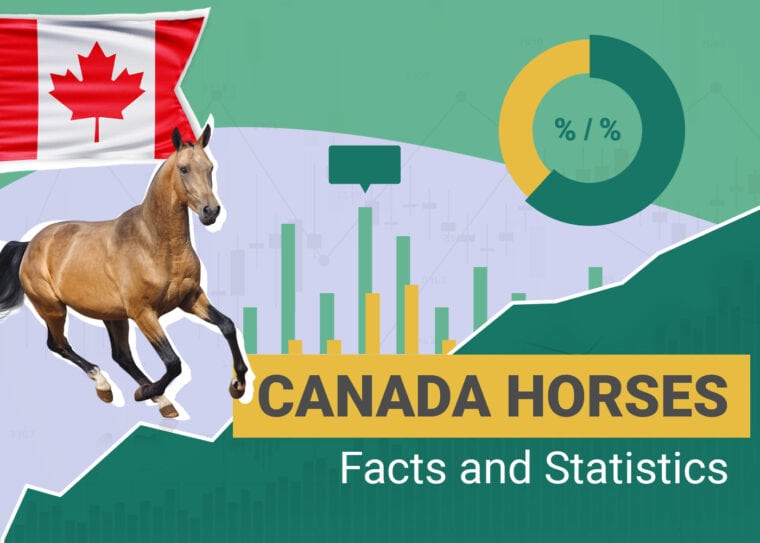
Click to Skip Ahead
Note: This article’s statistics come from third-party sources and do not represent the opinions of this website.
The horse industry in Canada is as diverse as its many provinces. Officially, horse industry activities are tracked and regulated by Equestrian Canada, but each province has its own regulatory board responsible for the development and growth of the horse industry. Events are held annually to promote the industry, provide sporting support, and offer opportunities for equine owners.
Since horses are tracked differently in each province and each province keeps track of horse industry statistics, it’s difficult to find information about the Canadian horse industry as a whole.
There are, however, a few interesting and uniquely Canadian stats that we think you’d love to know.
The 10 Canadian Horse Industry Statistics
- Canada’s equine sector contributed $8.69 billion to the country’s GDP in 2022.
- Canada is home to approximately 500,000 horses, with 855,000 people active in the equine industry.
- There are approximately 1,000 top-level equestrian athletes in Canada, which is home to 35 platinum-level events.
- Spruce Meadows, located just outside of Calgary, Alberta, is one of the biggest jumping locations in North America, hosting 500,000 visitors annually, with a stable capacity of 1,000 horses.
- Canada is one of the few countries to host the sport of chuckwagon racing. Races were held for the first time at the Calgary Stampede in 1923.
- 37% of Canada’s horses are located in Alberta.
- The average price for a Thoroughbred horse in Canada is $70,000.
- The number of feral horses in Sundre increased by 51% in 2023.
- Since 1986, 105 horses have died at the Calgary Stampede
- 2022 had the lowest rate of equine injuries in Thoroughbred racing since 2009, reporting 1.25 catastrophic injuries per 1,000 starts.

Canada-Wide Horse Industry Statistics
1. Canada’s equine sector contributed $8.69 billion to the country’s GDP in 2022.
(Equestrian Canada)
Alberta houses most of Canada’s horses at 37%, but Ontario isn’t far behind at 25%. Saskatchewan houses 13% of Canada’s equines. Nearly 28% of the country’s horses are used for recreation, 36% are used for professional sports, 19% are working horses, and 25% are used for amateur sports.
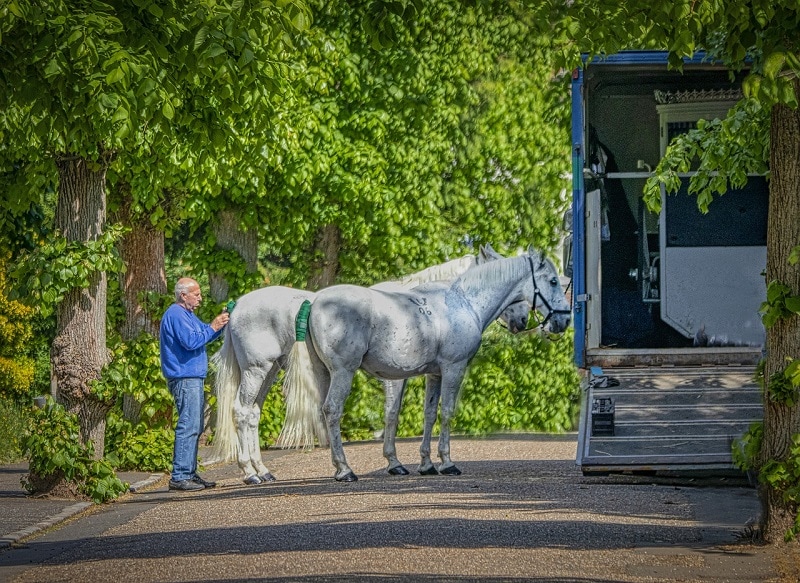
2. Canada is home to approximately 500,000 horses, with 855,000 people active in the equine industry.
(FEI.org)
Five hundred fifty thousand of these individuals live in horse-owning households, while 350,400 people have reported using horses owned by someone else. More adults participate than children, with a breakdown of 59% and 41%, respectively. The demographics of equestrian sports participants include an estimated 117,000 adults and 225,250 children.
3. There are approximately 1,000 top-level equestrian athletes in Canada, which is home to 35 platinum-level events.
(FEI.org)
These athletes have competed in platinum-level events, including the Olympics and Pan Am Games. They have also represented Team Canada in various World Championship events.
Four Canadians are currently in Jumping’s top 100 rankings in the world. Canada won gold in Dressage and Bronze in Eventing at the 2019 Pan Am Games.
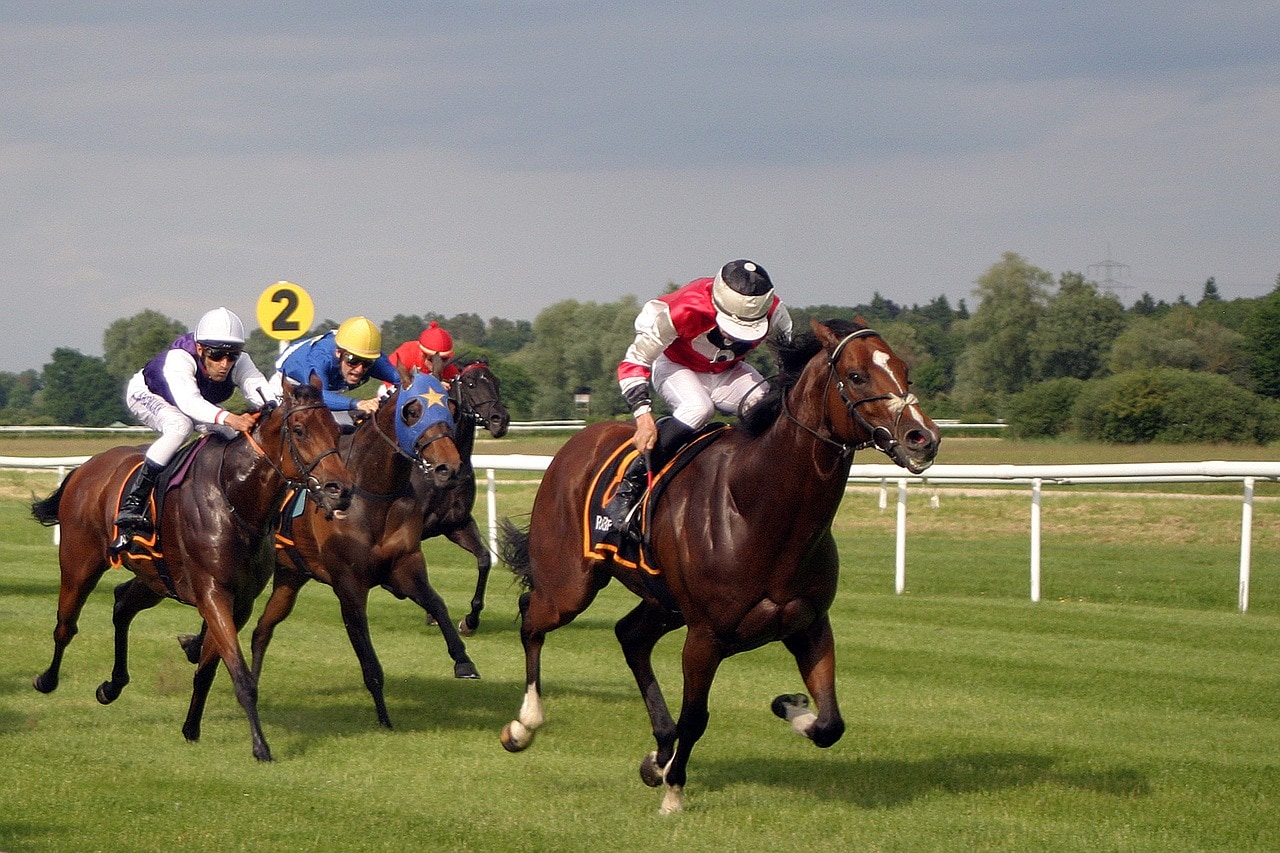
4. Spruce Meadows, located just outside of Calgary, Alberta, is one of the biggest jumping facilities in North America, hosting 500,000 visitors annually, with a stable capacity of 1,000 horses.
(FEI.org)
Thunderbird Show Park in Langley, B.C., is another major draw. It hosts nine major hunter and jumper tournaments each year, including Canada’s leg of the Longines FEI Jumping World Cup.
On the Western side, the Calgary Stampede is hosted every July in Calgary, Alberta. It hosts the Rangeland Derby, which is a chuckwagon racing competition and one of the largest rodeo competitions in North America. The Stampede also boasts cutting, reining, and penning competitions and world-class livestock shows.

5. Canada is the only country to host the sport of chuckwagon racing. Races were held for the first time at the Calgary Stampede in 1923.
(Canadian Museum of History)
Chuckwagon racing originated as a re-enactment of round-up races when wagon drivers raced each other to town. Although the rules have changed a bit over time, chuckwagon races are held throughout the prairie provinces during rodeo season.
Chuckwagons are hooked up to teams of four horses each and race around tracks of varying sizes, with Calgary’s track being the largest at ½ mile in length. When the horn blows, drivers must perform a figure eight around barrels in the infield, then race against either three or four (depending on the size of the infield and track) other wagons in a race to cross the finish line.
Alberta Horse Industry Statistics
6. 37% of Canada’s horses are located in Alberta.
(Equestrian Canada)
Ontario has the next highest number, followed closely by Ontario and Saskatchewan.

7. The average price for a Thoroughbred horse in Canada is $70,000.
(Horse Canada)
The price of a Thoroughbred changes based on each year’s racing results. When the breed wins more races with large purses, the price increases. Thoroughbreds and Warmbloods are popular English horses, particularly for Hunter/Jumper events. Quarter horses, Paints, and Arabians are used as working ranch horses, feedlot horses, or Western competitors.
It isn’t unusual for horse breeds to cross into different categories. For example, some Thoroughbreds compete in barrel racing.
8. The number of feral horses in Sundre increased by 51% in 2023.
(Calgary CTV News)
Canada has a healthy population of feral horses, and since 1990, the animals have been protected under the Stray Animals Act, which prohibits inhumane trapping methods, such as snares. The increase in horses in Sundre is considered an anomaly, and researchers believe it’s due to the increased use of aerial monitoring.
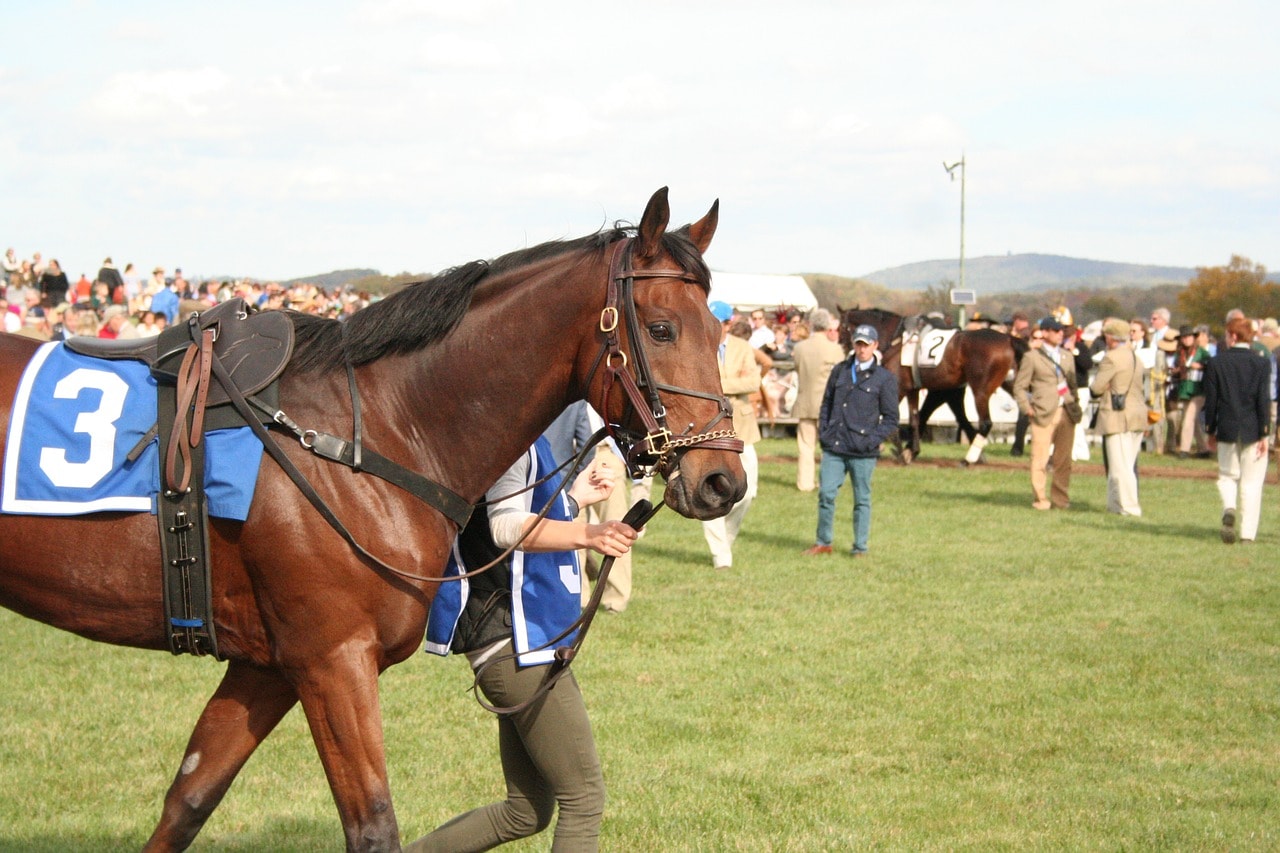
Horse Riding Injury Statistics
9. Since 1986, 105 horses have died at the Calgary Stampede.
(Vancouver Humane Society)
The rodeo is one of the most dangerous sports, and at the Calgary Stampede, chuckwagon horses have died more often than those in other events. Of the 105 deaths since 1986, 75 were chuckwagon horses.
10. 2022 had the lowest rate of equine injuries in Thoroughbred racing since 2009, reporting 1.25 catastrophic injuries per 1,000 starts.
(Thoroughbred Daily News)
This includes all the races held in North America. 2022 was the safest year for horses, and since 2009, fatal injuries have decreased by 37.5%. It’s also the fourth year in a row in which the fatal injury rate dropped.
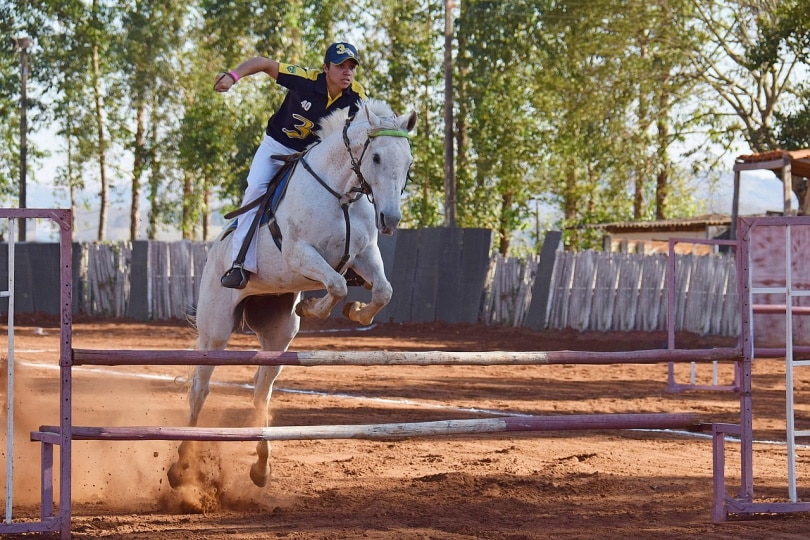
Frequently Asked Questions
Does Canada still slaughter horses?
Unfortunately, thousands of horses are sent to slaughter each year in Canada. Many of them are transported from the United States, as slaughter plants have been shut down in that country since 2007. Meat from slaughter plants is primarily exported to Europe and Asia, and Japan is the number-one importer of horse meat.
How Are Canadian officials handling the declining foal crop?
In 2023, the foal crop in Ontario dipped below 500 for the second year in a row. However, the Canadian Thoroughbred Society of Ontario rolled out an incentive program in 2024 to address the declining numbers. They provide a $1,500 bonus to breeders who produce Ontario-bred foals and a $2,500 bonus for foals produced by Ontario sires. (Bloodhorse)
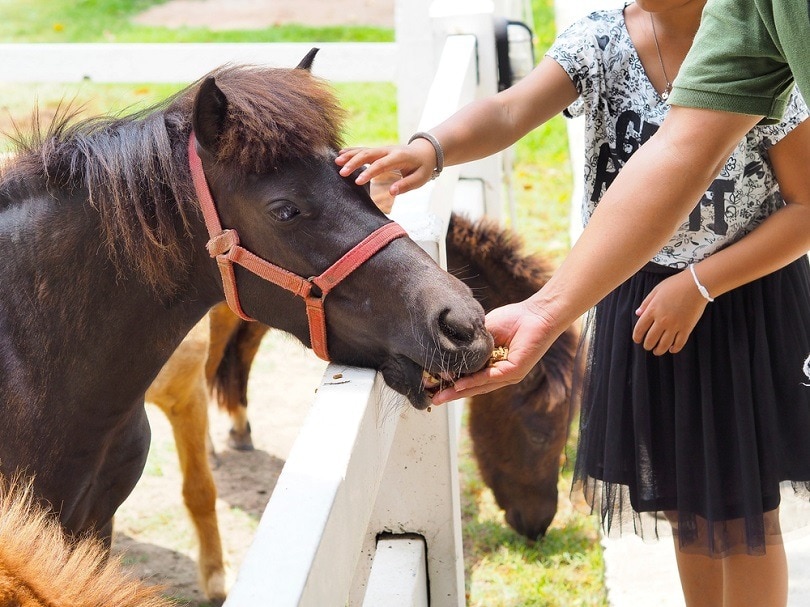
Do veterinarians typically assist breeders in the birthing process?
When horses are born on a farm, their breeders usually pay veterinarians to help them. It’s easier for a vet to visit the farm than for a horse to be transported to a veterinary facility. The costs for an uncomplicated birth can go up to $1,000, but when there are complications, the vet bill can exceed $2,500. (Horsesport)
What are the most popular equine racing events in Canada?
The Kentucky Derby is the most well-known horse race in the world, but Canada also holds world-famous seasonal races.
Here are the most popular horse racing events in the country
(Horseraceinsider)

Conclusion
The Canadian Horse Industry is thriving, with several world-class equestrian facilities and numerous horses and competitors. It boosts the Canadian economy and provides jobs in numerous economic sectors. Although some competitive equine sports are dangerous for riders and horses, improvements in training and safety practices have helped reduce the number of injuries.
Related Reads:
- Is Horseback Riding Considered a Sport?
- Australia Horse Statistics All Animal Lovers Should Know
- Canadian Dog and Cat Statistics All Pet Lovers Should Know
Featured Image Credit: Rita_Kochmarjova, Shutterstock






